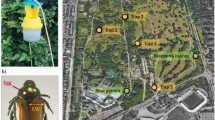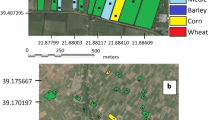Abstract
Multispecies sex pheromone trapping (trapping of more than one species in the same trap) for the bollworm,Helicoverpa (Heliothis) zea (Boddie); fall armyworm,Spodoptera frugiperda (J.E. Smith); armyworm,Pseudaletia unipuncta (Haworth); and the black cutworm,Agrotis ipsilon (Hufnagel) was evaluated. Baiting of individual traps with all possible combinations of the four species taken two at a time caused a reduction in the catches of at least one of any two species involved when compared to traps baited for only one species. These results demonstrated the species specificity of sex pheromones identified for these species. Although the effects were reduced in some cases, the interaction between species also was observed when adjacent traps were baited with the sex pheromone dispensers of the different species. These results indicate that the spacing between pheromone traps when more than one species are being trapped at the same site affects trap capture and should be evaluated further.
Similar content being viewed by others
References
Carpenter, I.E., Pair, S.D., andSparks, A.N. 1984. Trapping of different noctuid moth species by one trap baited with two lures.J. Ga. Entomol. Soc. 19:120–124.
Clement, S.L., Hill, A.S., Levine, E., andRoeloffs, W.L. 1981. Trap catches of maleAgrotis ipsilon with synthetic sex pheromone emitted from different dispensers.Environ. Entomol. 10:521–523.
Coudriet, D.L., andHenneberry, T.J. 1976. Captures of male cabbage loopers and pink boll-worms: Effect of trap design and pheromone.J. Econ. Entomol. 69:603–605.
Duncan, D.E. 1955. Multiple range and multiple F tests.Biometrics 11:1–41.
Farine, J.P., Frerot, B., andIsart, J. 1981. Factuers d'isolement chiminque dans la secretion pheromonale de deux noctuelles Hadeninae:Mamestra brassicae (L.) etPseudaletia unipuncta (Haw.).C.R. Acad. Sci. Paris Ser.III 292:101–104.
Hartstack, A.W., Jr., Witz, J.A., andBuck, D.R. 1979. Moth traps for the tobacco budworm.J. Econ. Entomol. 72:519–522.
Hartstack, A.W., Jr., Lopez, J.D., Muller, R.A., Sterling, W.L., King, E.G., Witz, J.A., andEversull, A.C. 1982. Evidence of long range migration ofHeliothis zea (Boddie) into Texas and Arkansas.Southwest. Entomol. 7:188–201.
Hartstack, A.W.,Lopez, J.D.,Muller, R.A., andWitz, J.A. 1986. Early season occurrence ofHeliothis spp. in 1982: Evidence of long-range migration ofHeliothis zea, pp. 48–60,in A.N. Sparks (ed.). Long-Range Migration of Moths of Agronomic Importance to the United States and Canada: Specific Examples of Occurrence and Synoptic Weather Patterns Conducive to Migration. USDA, ARS-43.
Hendricks, D.E., Hartstack, A.W., andRaulston, J.R. 1977. Compatibility of virelure and looplure dispensed from traps for cabbage looper and tobacco budworm survey.Environ. Entomol. 6:556–558.
Hill, A.S., andRoelofs, W.L. 1980. A female produced sex pheromone and attractant for males in the armywormPseudaletia unipuncta.Environ. Entomol. 9:408–411.
Hill, A.S., Rings, R.W., Suier, S.R., andRoelofs, W.L. 1979. Sex pheromone of the black cutworm,Agrotis ipsilon.J. Chem. Ecol. 5:439–457.
Klun, J.A., Plimmer, J.R., Bierl-Leonhardt, B.A., Sparks, A.N., Primiani, M., Chapman, O.L., Lee, G.A., andLepone, G. 1980. Sex pheromone chemistry of female corn earworm moth,Heliothis zea.J. Chem. Ecol. 6:165–175.
Lopez, J.D., Jr., andShaver, T.N. 1990. Plastic laminate dispenser for components of theHeliothis zea sex pheromone.Southwest. Entomol. 15:1–18.
Lopez, J.D., Jr., Shaver, T.N. andHartstack, A.W., Jr. 1981. Evaluation of dispensers for the pheromone ofHeliothis zea.Southwest. Entomol. 6:117–122.
McDonough, L.M., Kamm, J.A., andBierl-Leonhardt, B.A. 1980. Sex pheromone of the armyworm,Pseudaletia unipuncta (Haworth) (Lepidoptera: Noctuidae).J. Chem. Ecol. 6:565–572.
Mitchell, E.R. 1979. Monitoring adult populations of the fall armyworm.Fla. Entomol. 62:91–98.
Mitchell, E.R., Tumlinson, J.H., andMcNeil, J.N. 1985. Field evaluation of commercial pheromone formulations and traps using a more effective sex pheromone blend for the fall armyworm (Lepidoptera: Noctuidae).J. Econ. Entomol. 78:1364–1369.
Pair, S.D., andSparks, A.N. 1986. Evidence of annual long-distance migration in the fall armyworm, pp. 25–33,in A.N. Sparks (ed.). Long-range Migration of Moths of Agronomic Importance to the United States and Canada: Specific Examples of Occurrence and Synoptic Weather Patterns Conducive to Migration. USDA-ARS-43.
Raulston, J.R., Summy, K.R., Loera, J., Pair, S.D., andSparks, A.N. 1990. Population dynamics of corn earworm larvae (Lepidoptera: Noctuidae) on corn in the lower Rio Grande Valley.Environ. Entomol. 19:274–280.
SAS Institute. 1982. SAS User's Guide. SAS Institute, Inc., Cary, North Carolina.
Sekul, A.A., andSparks, A.N. 1976. Sex attractant of the fall armyworm moth. USDA Tech. Bull. 1542. 6 pp.
Showers, W.B., Whitford, F., Smelser, R.B., Keaster, A.J., Robinson, J.F., Lopez, J.D., andTaylor, S.E. 1989. Evidence of migration of the black cutworm adult in the U.S. corn belt.Ecology 70:987–992.
Steck, W.F., Undershill, E.W., Bailey, B.K., andChisholm, M.D. 1982. A 4-component sex attractant for male moths of the armyworm,Pseudaletia unipuncta.Entomol. Exp. Appl. 32:302–304.
Tumlinson, J.H., Mitchell, E.R., Teal, P.E.A., Heath, R.R., andMenglekock, L.J. 1986. Sex pheromone of fall armyworm,Spodoptera frugiperda (J.E. Smith): Identification of components critical to attraction in the field.J. Chem. Ecol. 12:1909–1926.
Turgeon, J.J., McNeil, J.N. andRoelofs, W.L., 1983. Field testing of various parameters for the development of a pheromone-based monitoring system for the armyworm,Pseudaletia unipuncta (Haworth) (Lepidoptera: Noctuidae).Environ. Entomol. 12:891–894.
Zvirgzdins, A., andHenneberry, T.J. 1983.Heliothis spp.: Sex pheromone trap studies. Proceedings Beltwide Cotton Prod. Res. Conf. pp. 176–180.
Author information
Authors and Affiliations
Additional information
This paper reports the results of research only. Mention of a commercial or proprietary product does not constitute an endorsement by the USDA.
Rights and permissions
About this article
Cite this article
Lopez, J.D., Shaver, T.N. & Goodenough, J.L. Multispecies trapping ofHelicoverpa (Heliothis) zea, Spodoptera frugiperda, Pseudaletia unipuncta, andAgrotis ipsilon (Lepidoptera: Noctuidae). J Chem Ecol 16, 3479–3491 (1990). https://doi.org/10.1007/BF00982112
Received:
Accepted:
Issue Date:
DOI: https://doi.org/10.1007/BF00982112




